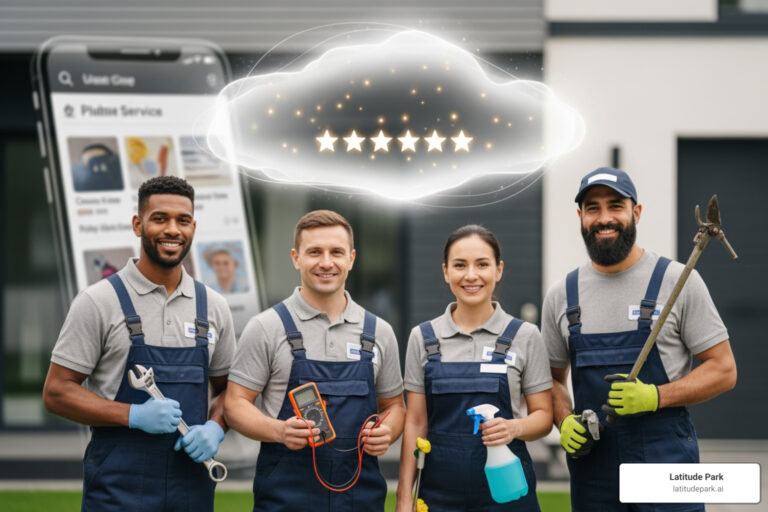If you're a small business owner, local marketing is your most direct line to customers who are nearby and ready to make a purchase. It’s a powerful strategy that blends online moves, like optimizing your Google Business Profile, with offline tactics, such as sponsoring the town's annual summer festival, to pull in a very specific, local audience. For example, a local bakery isn't just selling croissants; it's becoming the go-to spot for Saturday morning treats by being visible, trusted, and deeply connected to its neighborhood.
Why Local Marketing Is Your Greatest Advantage
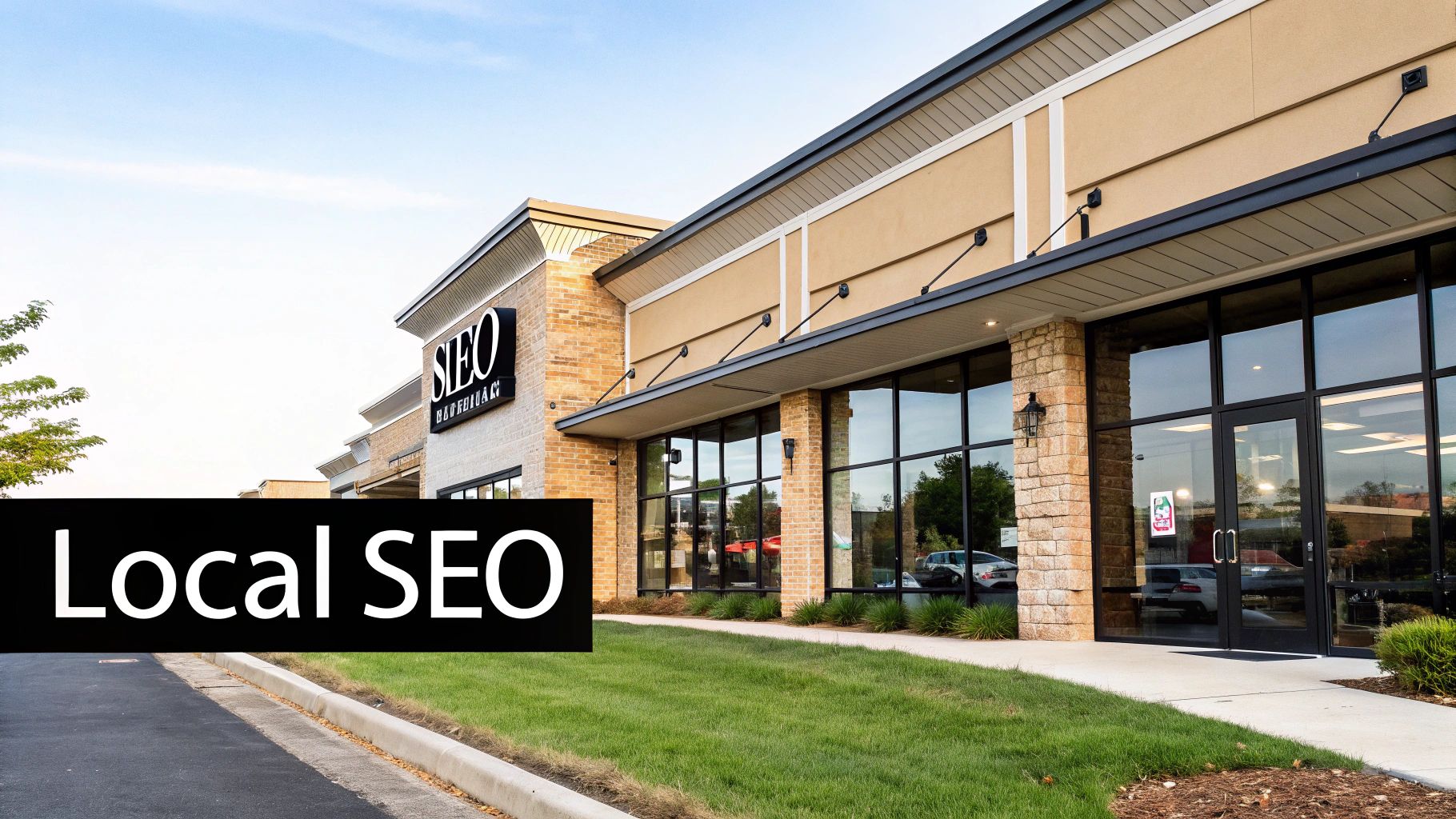
Trying to compete with national chains and their bottomless marketing budgets can feel like you’re bringing a knife to a gunfight. But what if your greatest strength isn't outspending them, but out-connecting with them on a local level? That’s the entire game plan behind local marketing—turning your spot in the community from just an address into your biggest competitive edge.
It’s all about becoming the first name that pops into someone’s head when they need what you sell. Think about it: a huge coffee chain might have a bigger ad budget, but they can't sponsor the local little league team or remember a regular's go-to order. A practical insight is that this hyper-local connection builds emotional equity. Those personal, community-focused touchpoints build a kind of loyalty that money just can't buy.
The Straight Line from Local Search to In-Store Sales
The link between someone searching locally on their phone and walking through your door is incredibly strong and direct. When a potential customer searches for "bakeries near me" or "emergency plumber," they aren't just browsing—they have an immediate need. Your job is to be the solution they find first.
This isn't just a hunch; the numbers tell the story loud and clear. A staggering 88% of consumers who look up a local business on their phone will call or visit that business within 24 hours. Even better, 78% of those searches result in a purchase.
This means that nearly every time a potential customer in your area pulls out their phone to find a service you provide, a sale is on the line. Being visible in that moment is everything.
Research backs this up, showing that 94% of high-performing brands have a dedicated local marketing strategy, while only 60% of average ones do. The connection is undeniable.
Prioritizing Your Efforts for Maximum Impact
With so many marketing channels out there, it’s easy to get overwhelmed. Where should you even start? Focusing on the right channels from the get-go ensures your time and money deliver the best possible returns. For a deeper dive, check out this a comprehensive guide to local business digital marketing.
Before we break down the most effective channels, here’s a quick overview of where to focus your energy for the biggest wins.
Top Local Marketing Channels for Small Businesses
| Channel | Primary Benefit | Example Tactic |
|---|---|---|
| Google Business Profile | Your digital storefront | Filling out every section with photos and getting reviews. |
| Local SEO | Showing up in local searches | Creating a webpage for "Plumbing Services in Springfield." |
| Customer Reviews | Building trust and credibility | Sending a follow-up text with a review link after a service call. |
| Community Engagement | Creating authentic connections | Partnering with a nearby coffee shop for a cross-promotion. |
By prioritizing these channels, you create a powerful local presence that attracts and keeps customers right in your neighborhood.
Let’s dig a bit deeper into these core pillars:
- Google Business Profile (GBP): Think of this as your digital front door. Keeping it updated with current hours, real photos, and fresh reviews is single-handedly the most important local marketing task you can do. A practical example: a restaurant should use the "Posts" feature to announce a weekly special.
- Local SEO: This is all about tweaking your website with local keywords (like "HVAC repair in Austin") so you pop up when people in your area search for what you do. An insight here is to create content about local landmarks or events to further anchor your site to the area.
- Customer Reviews: Positive feedback on Google, Yelp, and other sites is pure gold. It builds trust and heavily influences both customer decisions and your search rankings.
- Community Engagement: This is the heart of local marketing. Sponsoring events, partnering with other nearby businesses, and joining local groups forge genuine connections that national brands can't replicate.
By building on these four areas, you create a solid foundation for growth. Each one supports the others, creating a local marketing machine that works for you 24/7.
Building Your Digital Storefront With Local SEO
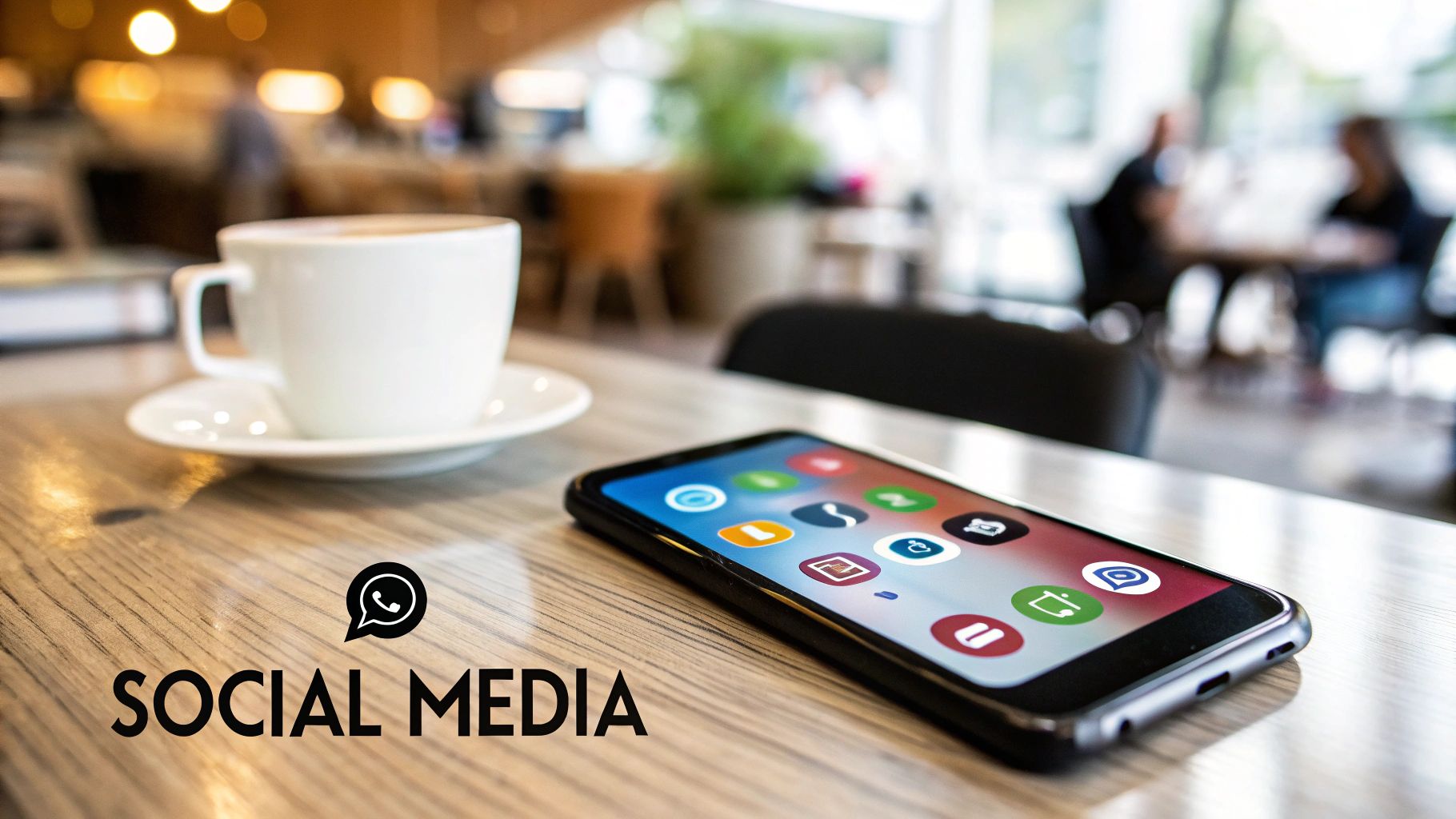
Think of your online listings as the modern-day front door to your business. It's often the very first place local customers will meet your brand. Optimizing these listings isn't just a good idea; it's a fundamental step in building a digital presence that actually drives foot traffic.
This is where local SEO (Search Engine Optimization) becomes your most valuable employee. It works around the clock to make sure you show up when and where it matters most.
Local SEO isn't about taking on the entire internet. It's about winning the attention of people right in your neighborhood. The goal is simple: when someone nearby needs what you offer, your business should pop up first. A practical example: if a tourist searches for "best souvenirs in downtown," a well-optimized local gift shop should appear in the top results.
And people are searching. Nearly a third of Americans search online for local business information every single day. This makes a strong, optimized digital presence absolutely vital for survival and growth.
Perfecting Your Google Business Profile
Just claiming your Google Business Profile (GBP) is step zero. The real work—and the real results—come from optimizing every single field to its full potential. You should treat your GBP like a mini-website that Google gives top priority in local search results.
Let's start with your business categories. Don't just pick one generic option. Google lets you select a primary category and several secondary ones. Be specific.
- Primary Category: This needs to be the most accurate description of your core business. For a cafe, this is "Coffee Shop."
- Secondary Categories: Now, add your other relevant services. That same cafe could add "Bakery," "Sandwich Shop," or "Restaurant."
A practical example for a mechanic: don't just list "Mechanic." They should add "Brake Shop," "Oil Change Station," and "Auto Air Conditioning Service." This level of detail is exactly what helps Google match you with more specific, high-intent customer searches like "car AC repair near me."
Next, it's time to craft a compelling business description. This is your chance to shine and weave in local keywords naturally. Instead of a bland "We fix cars," a mechanic in the city center could write, "Your trusted downtown source for fast and reliable car repair. We specialize in everything from routine oil changes to complex engine diagnostics for our city's drivers." See the difference? It's both informative and locally focused.
The Critical Role Of NAP Consistency
One of the most crucial elements for local SEO success is NAP consistency. This stands for your Name, Address, and Phone number. This information must be absolutely identical across every single online platform where your business is listed.
A practical insight: even a small inconsistency, like using "St." on one site and "Street" on another, can confuse search engines and harm your local ranking. This signals a lack of reliability to Google, which can push you down in search results.
This consistency has to extend far beyond your Google profile. It needs to be uniform across all major online directories. To truly get this right and maximize your visibility, many businesses find that dedicated Local SEO services for small business growth are essential for creating a cohesive online presence.
Leveraging Local Directories And Visuals
While Google is king, other online directories still carry significant weight. Getting listed on them builds your credibility and creates valuable "citations"—mentions of your business's NAP information.
Here are a few essential directories every local business should be on:
- Yelp: A powerhouse for service-based businesses like restaurants, salons, and contractors.
- Bing Places: Don't forget the second-largest search engine's version of Google Business Profile.
- Nextdoor: A hyperlocal platform perfect for connecting directly with residents in your immediate neighborhood.
- Industry-Specific Sites: A practical example: for a contractor, this could be Angi. For a doctor, it might be Healthgrades.
Ensuring your business is accurately listed in these key places builds a strong web of trust signals for search engines.
Finally, use photos to tell your brand's story. A profile with high-quality, authentic images gets far more clicks and engagement. Don't just upload a logo and call it a day. A practical example: a gym should post photos of its equipment, class spaces, and personal trainers in action. Show your team, your workspace, your products, and happy customers (with their permission, of course). These visuals provide powerful proof of your quality and help potential customers feel a connection before they even walk through your door.
Earning Community Trust Through Customer Reviews
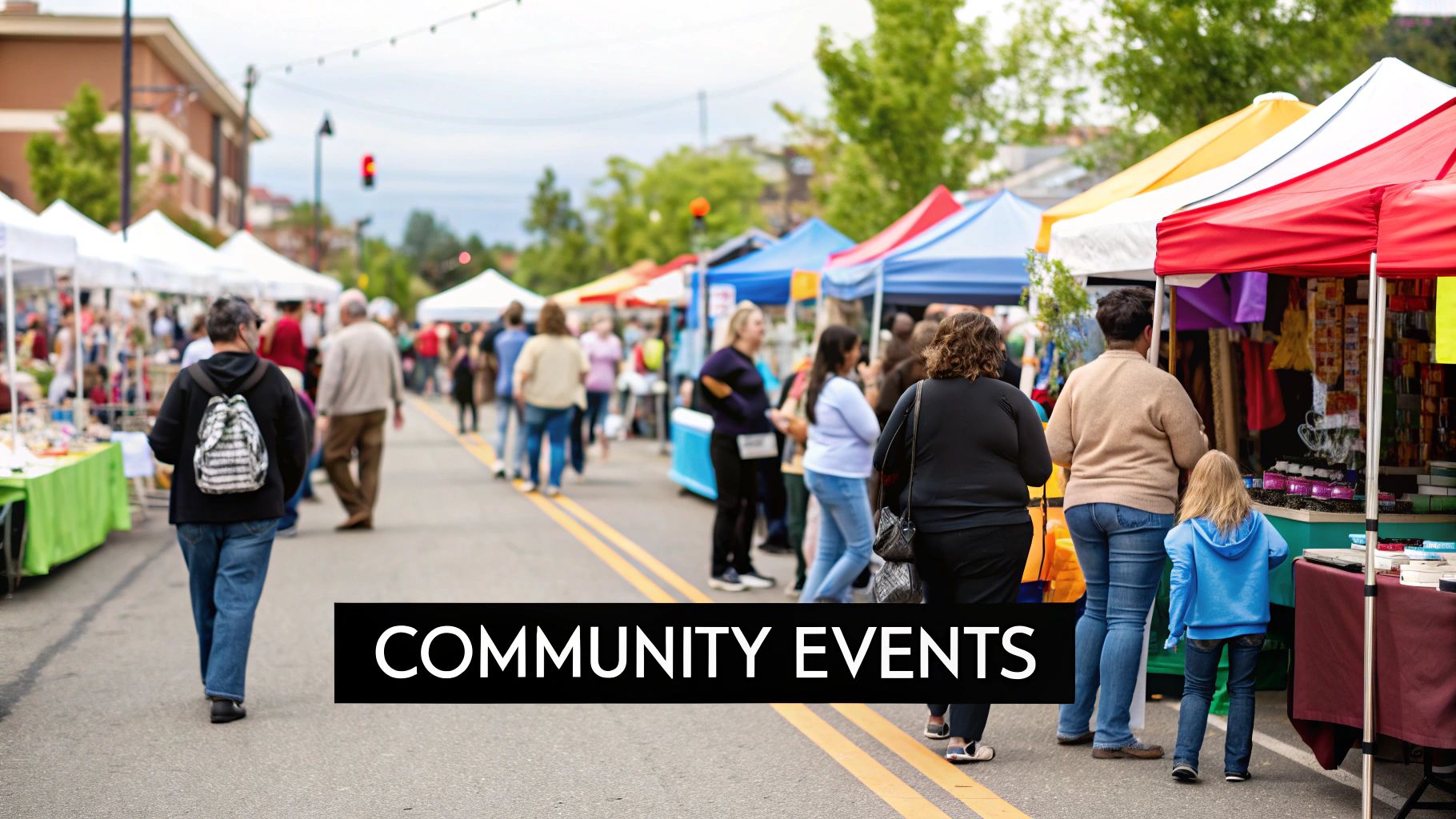
When it comes to local marketing, your reputation isn't just what you say about your business—it's what your customers say about you. Reviews are the new word-of-mouth, and they can either build incredible community trust or turn potential customers away before they even give you a look.
Think about it. Today, online ratings are one of the first things people check. In fact, over 83% of customers use Google to look up local business reviews before making a decision. This makes a steady flow of positive feedback absolutely essential for any small business marketing strategy.
How to Authentically Ask for Reviews
The real secret to getting great reviews? Just ask your happiest customers at the right moment. The goal is to make the request feel like a natural part of a great experience, not a pushy sales tactic. The best time to pop the question is right after a positive interaction when their satisfaction is at its highest.
Let’s say a customer at your boutique raves about the personal styling help they just received. That’s your perfect opening. You could say, "I'm so glad we could help you find the perfect outfit! If you have a moment, sharing your experience on Google would mean the world to our small shop."
To make this a repeatable process, you can create simple, personal-feeling templates for email or text messages.
Example SMS Template:
"Hi [Customer Name], thanks again for stopping by [Your Business Name] today! We loved having you. If you have 30 seconds, would you mind sharing your experience? It helps other locals find us. Here's a direct link: [Link to Google Review Page]"
This approach is polite, direct, and makes it incredibly easy for them to act. The less friction, the better.
Responding to Every Review—The Good and The Bad
Getting reviews is only half the job. Responding to them is where you truly solidify trust. When you actively engage, you’re showing everyone that you listen and genuinely care about the customer experience—and that’s a massive differentiator. In fact, an impressive 89% of U.S. consumers are more likely to use a business that responds to all of its online reviews.
Responding to positive reviews is your chance to show appreciation and double down on what makes your business great.
- Positive Review Response Tip: Always personalize it. Mention a specific detail from their review to prove you actually read it. Instead of a generic "Thanks for the review," try something like, "We're so happy you enjoyed the pepperoni pizza! It's a team favorite, too. Hope to see you again soon!"
But how you handle negative feedback is even more critical. A thoughtful, public reply can turn a bad situation around and show every potential customer who reads it just how professional you are. Our article on why having great online business ratings will help your company succeed dives deeper into this dynamic.
A Real-World Scenario: Handling Negative Feedback
Imagine you run a local pizzeria and a customer leaves a one-star review: "Ordered a large supreme, got a small cheese instead. Delivery took forever. Very disappointed."
Ignoring this is not an option. Getting defensive is even worse. Here’s a practical, step-by-step example of how to turn this into a win:
- Acknowledge and Apologize: Start by validating their frustration. "Hi [Customer Name], thank you for your feedback. I am so sorry to hear about the mix-up with your order and the delay. That's definitely not the experience we want for our customers."
- Take Responsibility (No Excuses): Show you're taking action. "We're looking into what happened with our kitchen and delivery team to ensure this doesn't happen again."
- Make It Right: Offer a real solution. "We would love a chance to make this right. Please call us at [Phone Number] and ask for [Manager's Name]. Your next pizza is on us."
This kind of response transforms a complaint into a public display of excellent customer service. It proves you're accountable and committed to quality. Beyond reviews, there are many proven strategies to build customer trust that can dramatically improve your local reputation.
By creating a system for both generating and managing reviews, you build a powerful asset that boosts your local search ranking and cements your place as a trusted community business.
How to Engage Your Community Beyond The Storefront
Real local marketing goes way beyond what you can do with a digital ad or a perfectly optimized online listing. It’s about truly weaving your business into the fabric of the neighborhood.
This is where you become a genuine neighbor, not just another business trying to sell something. These offline, community-focused strategies are how you build unshakable loyalty and spark the kind of powerful word-of-mouth that digital ads just can't buy.
It’s the difference between being a place people buy from and a place they believe in. When customers see you showing up for the community, they feel a connection that translates directly into loyalty.
Sponsor Local Events and Teams
One of the most powerful ways to show you’re invested in your community is through local sponsorships. It gets your brand name in front of engaged local families in a positive, supportive way. Think about where your community gathers and what they rally around.
A practical example: Sponsoring a little league team, a high school robotics club, or the annual town festival are all fantastic ways to boost your visibility. Seeing your logo on a team jersey or a banner at a packed event creates a positive association that sticks.
It’s not just advertising; it's a visible investment in the things that make your town a great place to live. It shows you care about more than just the bottom line, positioning your business as a pillar of the community and building goodwill that pays dividends for years.
Host Valuable Workshops and Classes
Another fantastic way to connect is by sharing what you know. Hosting a free workshop or a low-cost class on a topic you’re an expert in can draw new people into your orbit and establish you as the go-to authority.
For example:
- A local hardware store could host a free "DIY Basics" workshop for new homeowners, covering simple repairs they can do themselves.
- A bakery might offer a fun weekend class on sourdough bread making for a small fee.
- A financial advisor could hold a complimentary seminar on retirement planning at the local library.
These events provide real value without a heavy sales pitch. It's a relationship-first approach that builds trust and brings potential customers right to your door, often leading to sales down the road.
Forge Authentic Local Partnerships
Teaming up with a non-competing, complementary business can introduce you to a whole new customer base and create unique experiences for the community. The trick is finding partners whose values and audience align with yours.
A practical insight: think of it as a force multiplier for your local marketing. A smart partnership lets both businesses pool resources, share audiences, and create an offer that’s far more compelling than what either could do alone.
Recent analysis backs this up, showing that 55% of consumers actually want to see more collaboration among local small businesses. That’s a clear signal to get creative with cooperative marketing.
Here’s a real-world scenario:
A local hardware store noticed a thriving community garden just a few blocks away. They partnered up to host a "DIY Planter Box" weekend workshop. The garden promoted it to its members, while the hardware store offered a nice discount on all the needed supplies—wood, soil, and seeds. The event was a smash hit, driving foot traffic and incredible goodwill for both. A perfect win-win.
Look around your own neighborhood. The coffee shop next door, the boutique down the street, or the local non-profit are all potential allies. Brainstorm a joint promotion, co-host an event, or even just swap flyers.
Embrace Community Involvement and Social Responsibility
Today’s consumers are drawn to businesses that give a damn. In fact, a whopping 63% of consumers want to see businesses get more involved in community issues and events. This tells us that social responsibility isn't just a "nice-to-have" anymore—it's a core part of smart local marketing. You can see more on this by reviewing these small business marketing statistics.
This doesn't mean you need a huge budget. A practical example: it can be as simple as organizing a food drive, volunteering as a team at a local charity, or donating a portion of your sales on a specific day to a local cause like the animal shelter.
These actions speak volumes, building a reputation as a business that genuinely gives back to the community that supports it.
Running Smart Local Ads On A Tight Budget
Paid advertising often brings to mind massive budgets and sprawling campaigns, a world that can feel completely out of reach for a small business owner. But here’s the thing: running effective local ads has very little to do with having the deepest pockets. It’s all about being smart, strategic, and laser-focused.
The real power of local advertising is in its precision. Forget shouting into the digital void. This is about whispering directly to potential customers who are just around the corner, often looking for exactly what you offer. This is where hyperlocal targeting becomes your absolute best friend.
Laser-Focus Your Audience With Geotargeting
Modern ad platforms like Google Ads and Facebook Ads have some seriously powerful tools that let you draw a virtual fence around a specific area. We call this geofencing, and it’s a game-changer because it means your ads are only shown to people within that hand-drawn circle.
Imagine you own a yoga studio. Instead of blasting an ad across the entire city, you could set a simple one-mile radius around your studio's front door. Now, your special offer for a "First Week Free" class pass only pops up on the social feeds of people physically in that zone—the very people most likely to actually show up and become members.
Here are more practical examples of this in the real world:
- A coffee shop could target a two-block radius during the morning commute (7-9 AM) with an ad for a "Coffee and Croissant" special.
- A pet supply store might run an ad targeting users within a half-mile of the local dog park on a sunny Saturday.
- A bookstore could target the neighborhood around a university campus during the first week of the semester.
This kind of surgical precision means you stop wasting money on eyeballs that will never turn into footsteps. Every single ad dollar works harder. For a complete walkthrough on setting these up, our Google Ads local business guide breaks down the exact steps.
Create Social Content That Connects Locally
Your social media ads and posts need to do more than just sell. To really hit home with a local audience, your content has to feel like it’s coming from a neighbor, not a faceless corporation. This is about building a community, not just a customer list.
A practical example: think about showing off the human side of your business. A staff spotlight introducing your new barista or a quick behind-the-scenes video of your team prepping for a busy Saturday can create so much more connection than another discount announcement ever could.
The most effective local content doesn't just promote a product; it shares a story. A key insight: it makes your audience feel like they're part of something, fostering a connection that builds long-term loyalty.
Tap into what’s happening around you. Did the local high school football team just pull off a big win? Post a "Congrats!" message. Is there a farmer's market down the street? Share a photo of the fresh produce you just bought for your restaurant. It shows you’re a real, active part of the neighborhood.
Track The Metrics That Actually Matter
For a local business, clicks and impressions can be pure vanity. They feel good, but they don't pay the bills. What you really need to be tracking are the actions that lead directly to revenue. Did someone call your business after seeing your ad? Did they tap the "Get Directions" button? These are the conversions that count.
Make sure your ad campaigns are set up to track these specific, high-value actions:
- Phone Calls: See how many people tapped the "Call" button straight from your ad.
- Direction Requests: Measure how many users clicked for directions to your physical storefront.
- Store Visits: For brick-and-mortar shops, platforms like Google Ads can even track how many people saw your ad and then walked through your door.
- Local Action Conversions: A practical example here includes valuable clicks on your menu, reservation links, or appointment-booking buttons.
By focusing on these tangible outcomes, you get a crystal-clear picture of your return on investment. You'll know exactly which ads are driving real-world business, which means you can double down on what works and cut what doesn't, all with complete confidence.
Your Local Marketing for Small Business Action Plan
Alright, let's turn all this strategy into a real, workable plan. A great local marketing approach isn't about throwing everything at the wall to see what sticks. It’s about building a smart, connected system where every piece of your marketing works together. The goal? To create a machine that consistently brings local customers through your door.
This infographic really simplifies the whole process, breaking it down into three logical stages that build on each other.
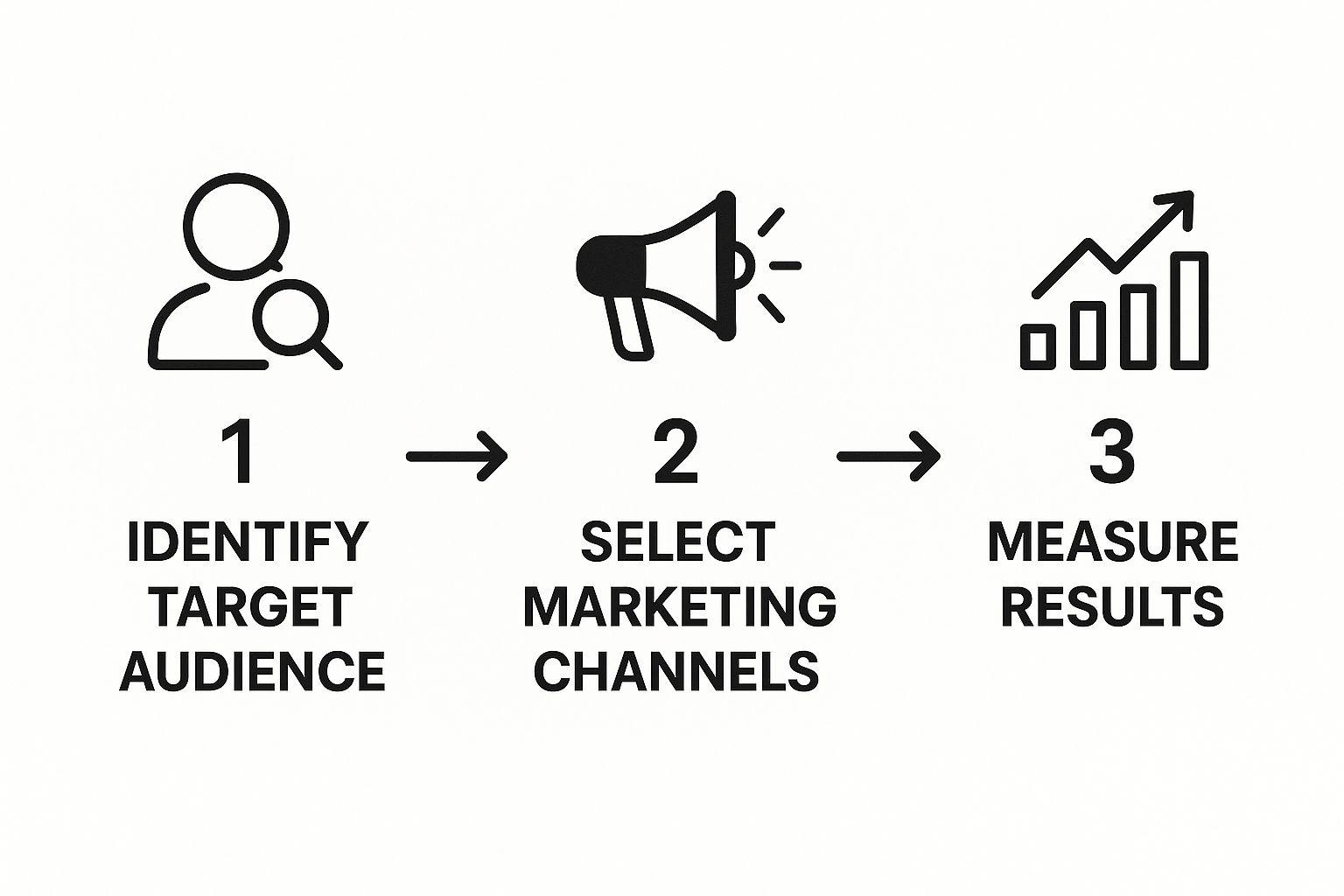
As you can see, figuring out your audience first is what makes everything else—from choosing your marketing channels to measuring what works—so much more effective.
To bring this to life, here’s a straightforward monthly checklist. It’s designed to help you build real momentum, one month at a time.
Your Monthly Action Checklist
- Month 1: Pour all your energy into your digital storefront. This means fully optimizing every single section of your Google Business Profile. A practical goal: upload 10 new photos (interior, exterior, products, team). Once that's done, get proactive and start asking for your first 5-10 customer reviews.
- Month 2: Time to build some community muscle. Find one potential community partner—another local business, a neighborhood group—and reach out about a joint event or a simple cross-promotion. For example, a florist could partner with a local chocolatier for a Valentine's Day package.
- Month 3: Now, let's dip a toe into paid advertising. Run a small, super-focused ad campaign on Facebook. Target a tight, one-mile radius around your business and give them a great reason to stop by with a compelling offer like "Show this ad for a free coffee with any purchase."
Frequently Asked Questions
Ever wonder how your favorite coffee shop or local service seems to be everywhere you look online? It’s not magic—it's smart local marketing. Let's tackle some of the most common questions business owners ask when they're ready to get serious about growing locally.
How Much Should I Spend On Local Marketing?
There’s no magic number here, but a solid rule of thumb is to earmark 5-10% of your revenue for your marketing efforts.
The best part? You can start without spending a dime. Focus first on the high-impact, free tools at your disposal. Fully optimizing your Google Business Profile and actively encouraging customer reviews costs you nothing but your time and can deliver incredible results. A practical insight: dedicating one hour per week to these tasks can yield significant returns over a few months.
Once you see a tangible return from that foundation, you can start to strategically scale up. Begin funneling a small portion of your budget into paid channels, like hyperlocal social media ads. The key is to reinvest in what’s already proven to bring new customers through your door.
What Is More Important: Local SEO Or Local Ads?
Think of them as a team, not competitors. They work best when they work together.
Local SEO is your long-term foundation. It’s the slow-and-steady work that builds organic trust and visibility, paying dividends over time without needing a constant cash injection. It’s the bedrock of your local digital presence.
On the other hand, local ads deliver a powerful, short-term boost. They're perfect for shouting about a flash sale, promoting a weekend event, or quickly reaching a new pocket of customers in your neighborhood. A practical example: a restaurant can use local ads to promote a last-minute dinner special on a slow Tuesday night.
Our advice: Nail your local SEO first. Once that solid foundation is in place, you can strategically layer in local ads as your budget and business goals allow. It’s the one-two punch every small business needs.
How Do I Get More Customer Reviews Without Being Pushy?
It all comes down to timing and making it effortless. The secret is to ask when a customer's positive feelings are at their absolute peak.
The perfect moment is right after a great experience—like when they’re complimenting your service or raving about a product they just bought. A practical example: a hairdresser can say, "I'm so glad you love your new color! If you get a chance, a quick review on Google would be amazing."
You can also send a simple, personalized follow-up email or text a day after their visit. A friendly note like, "We loved having you! If you have a moment, sharing your experience on Google helps our small business a lot," feels genuine, not demanding.
The most critical part? Give them a direct link. The less work they have to do, the more likely they are to leave that glowing review.
Can I Do Local Marketing Myself, Or Do I Need An Agency?
You can absolutely start this journey yourself. The core elements of local marketing—managing your Google profile, responding to reviews, and engaging with your community on social media—are completely manageable for a hands-on business owner.
As your business grows, or when you want to scale up with more complex strategies like ongoing ad campaigns and consistent content creation, bringing in help can be a very smart investment. A freelancer or a specialized agency can save you precious time and bring expert knowledge to the table, accelerating your growth. This is especially true as you adapt to constant search engine changes; in fact, a recent report found 86% of local marketers say their clients understand how algorithm updates impact their visibility, highlighting the value of staying informed. You can explore more insights about local SEO trends and their impact on businesses.
Ready to stop guessing and start growing? Latitude Park specializes in running high-performance Meta ads, Google ads, and SEO for franchises and small businesses. We take the complexity out of local marketing so you can focus on what you do best. Let's build your local presence together—visit us at https://latitudepark.com to learn more.








